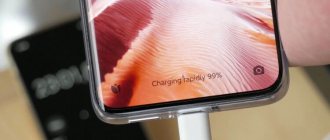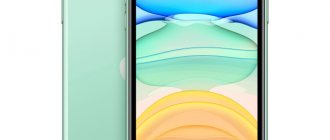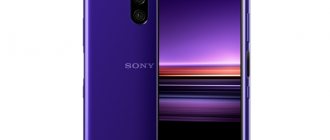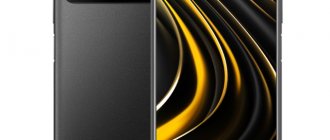The processor is one of the main parts of any mobile phone, and when choosing a device, it is important to evaluate this part. The rating of mobile processors will help you understand which one is better. We present it, as well as a list and rating of manufacturers, in this article. Depending on how powerful the processor is installed in the phone, the performance and power of the device largely depend. Let's look at what you need to look for when choosing a processor, and also figure out which chip can be considered good and feel free to choose a phone in which it is installed.
Rating of the best mobile processors for smartphones
| Photo | Name | Rating | Price | |||
| Smartphone processors with good performance | ||||||
| #1 | Qualcomm Snapdragon 730G | ⭐ 4.95 / 5 | Read review | |||
| #2 | HiSilicon Kirin 810 | ⭐ 4.9 / 5 | Read review | |||
| #3 | Qualcomm Snapdragon 712 | ⭐ 4.85 / 5 | Read review | |||
| #4 | HiSilicon Kirin 970 | ⭐ 4.8 / 5 | Read review | |||
| #5 | Qualcomm Snapdragon 710 | ⭐ 4.75 / 5 | Read review | |||
| #6 | Mediatek Helio P90 | ⭐ 4.7 / 5 | Read review | |||
| #7 | Qualcomm Snapdragon 665 | ⭐ 4.65 / 5 1 - voice | Read review | |||
| The most powerful processors | ||||||
| #1 | Qualcomm Snapdragon 855 | ⭐ 4.95 / 5 5 — votes | Read review | |||
| #2 | Apple A13 Bionic | ⭐ 4.95 / 5 1 - voice | Read review | |||
| #3 | Apple A12 Bionic | ⭐ 4.9 / 5 | Read review | |||
| #4 | Samsung Exynos 9820 | ⭐ 4.85 / 5 3 - votes | Read review | |||
| #5 | HiSilicon Kirin 980 | ⭐ 4.8 / 5 1 - voice | Read review | |||
Which mobile processor would you choose or recommend?
Take the survey
We compiled this rating based on independent user ratings and reviews of specialists that are posted on the network for a particular processor. Please note that our site does not cooperate with stores, but only focuses on the opinions of customers and knowledgeable people. We do not claim high accuracy of the list, and the editors' opinions may not coincide with the opinions of other users.
The list below shows the processors that are now most often used in smartphones. They are distinguished by performance and allow you to make your phone powerful and efficient. But the technical characteristics of the devices are different in any case, and they greatly depend on what processor is installed inside the phone. For convenience, we have divided the list into two categories, combining the most powerful chips and those with simpler characteristics. Also at the very bottom you will find a rating of the manufacturers of these parts.
Smartphone processors with good performance
No. 7 - Qualcomm Snapdragon 665
Qualcomm Snapdragon 665
A mid-priced processor that has eight cores, is moderately priced and has good performance. Can be installed on both smartphones and tablets.
Technical process 11 nm, frequency - 2200 MHz, release year - 2021. The processor heats up less than its predecessor and also has higher energy efficiency. The improved graphics unit Adreno 640 allows for better graphics and image processing. The processor is divided into two clusters with 2 and 6 cores, respectively. Both clusters can be used at the same time. There is support for a dual-channel LPDDR4 memory controller, Bluetooth 5 and a modem with a good level of data transfer. The main disadvantage is the lack of support for Quick Charge 4 fast charging.
pros
- good energy efficiency
- good performance
- eight cores
- improved graphics unit
- high level of data processing
Minuses
- does not support Quick Charge 4 level fast charging
Prices for smartphones with Qualcomm Snapdragon 665 processor
smartphones with Qualcomm Snapdragon 665 processor
No. 6 – Mediatek Helio P90
Mediatek Helio P90
For a long time, Mediatek was considered far from the best and fairly budget processor, but now the situation on the market has begun to change. The Helio P90 processor is an example of this. It will be able to handle even a flagship phone model, albeit not at the highest level. In any case, the model makes it to the list of the best.
Processor 2018-2019, with a 12 nm process technology, eight-core structure, with a PowerVR GM 9446 video accelerator. Architecture: 2* Cortex-A75 + 6*Cortex A55. To some extent, this processor variant was able to outperform even the Snapdragon 710.
The processor supports up to 8 GB of RAM and works smoothly with a 48 MP camera or two cameras of 16 and 24 MP. It also supports UFS 2.1 solid-state drives and screen resolutions of 2520*1080. There is an adaptation of characteristics to the running application, so that a phone with such a processor will not freeze. But, unfortunately, this device is not very energy efficient.
pros
- many cores
- powerful processor
- RAM support up to 8 GB
- updated block for working with photos
- work with cameras up to 48 MP
Minuses
- not the most energy efficient
- old generation GPU
Prices for smartphones with Mediatek Helio P90 processor
smartphones with Mediatek Helio P90 processor
No. 5 – Qualcomm Snapdragon 710
Qualcomm Snapdragon 710
Processor for Android, good and productive, but a little short of what it can be installed in flagships. This is the first “seven hundred” in the entire Qualcomm line, suitable for mid-range smartphones.
Released in 2021, has a 10 nm process technology. It has 8 cores, two of which are clocked at 2.2 GHz (ARM Cortex A75), and the remaining six are ARM Cortex A55 clocked at 1.7 GHz. Does not emit much heat energy, productive and efficient. Video accelerator - Adreno 616. The processor allows you to work well with graphics and photos, perfectly processes images from a pair of cameras up to 16 megapixels, shoots in 4K, and is capable of supporting face recognition. Handles powerful games and does not heat up. At the same time, the price of the chipset is quite low. The option also supports Quick Charge 4.
pros
- inexpensive
- consume little energy
- 4K support
- supports Quick Charge 4 fast charging
- eight cores
- facial recognition support
Minuses
- Does not support camera stabilization
Prices for smartphones with Qualcomm Snapdragon 710 processor
smartphones with Qualcomm Snapdragon 710 processor
No. 4 - HiSilicon Kirin 970
HiSilicon Kirin 970
Processor from Huawei, which has eight cores and copes with serious tasks, despite the fact that it was released in 2021. And it was announced, by the way, back in 2021. Two years have passed, and it is still in use - a long time for a processor in modern realities.
The device has a 10 nm process technology, has 4 cores 2.36 GHz (Cortex-A73) and the same number, but with a frequency of 1.84 GHz (Cortex-A53). But compared to its predecessor, this processor model is now capable of downloading data from the network at a higher speed. The Mali G72 MP12 is responsible for the graphics; it also allows you to run fairly heavy games that require high performance. The processor also has the ability to “train” the phone.
pros
- can train a smartphone
- loads data quickly
- handles games that require high performance
- eight cores
- greater productivity and energy efficiency
- Support 4K video recording and playback
Minuses
- unknown
Prices for smartphones with HiSilicon Kirin 970 processor
smartphones with HiSilicon Kirin 970 processor
No. 3 - Qualcomm Snapdragon 712
Qualcomm Snapdragon 712
Announced in 2021, an updated and quite powerful processor than its predecessor 710. Performance has increased by about 10%. Artificial intelligence technologies are fully implemented.
The model has eight cores with a frequency of 2.3 GHz, a 10 nm process technology. Support for excellent graphics quality is provided by Adreno 616. TrueWireless Stereo Plus and Broadcast Audio technologies are also implemented, which will allow you to get excellent sound when using wireless headphones. And in games, a smartphone with such a processor will sound better than with its predecessors. In addition, the processor supports the ability to use the Quick Charge 4+ function. It can also work with a camera of up to 32 megapixels or a double variation of up to 20 megapixels. AI technologies make it possible for the phone to adapt to the shooting conditions. The photos are of high quality, even if you take several pictures at once.
pros
- provides high quality shooting
- makes it possible to realize high-quality sound
- supports Quick Charge 4+
- high performance
Minuses
- not detected
Prices for smartphones with Qualcomm Snapdragon 712 processor
smartphones with Qualcomm Snapdragon 712 processor
No. 2 - HiSilicon Kirin 810
HiSilicon Kirin 810
A good and fast processor from Huawei. It consumes little energy and takes good positions in the ratings, outperforming even the TOP Snapdragon 855 in some parameters (in the artificial intelligence performance test).
Release date: summer 2021. Technological process - 7 nm. It has eight cores, two of which are considered high-performance (Cortex-A76) and have a frequency of 2.27 GHz, and six are energy-efficient (Cortex-A55) with a frequency of 1.88 GHz. GPU type Mali-G52, which, thanks to the presence of special technology, allows you to speed up the processor when launching games. A device with such a processor can easily take pictures in the dark. Used in mid-priced Huawei and Honor smartphones.
pros
- doesn't heat up much
- allows you to process photos in the dark
- high data processing speed
- used in low-cost smartphones
- in a number of characteristics competes with TOP processors
Minuses
- Doesn't allow you to shoot in 4K
Prices for smartphones with HiSilicon Kirin 810 processor
smartphones with HiSilicon Kirin 810 processor
No. 1 - Qualcomm Snapdragon 730G
Qualcomm Snapdragon 730G
Mid-range processor with eight cores, the development of which focused on improving the quality of intelligence and performance. The model copes well with complex tasks when compared with earlier versions.
The processor has 2 cores with a frequency of 2.2 GHz (this is ARM Cortex-A76) and 6 cores of the ARM Cortex-A55 type, with a frequency of 1.8 GHz. The device contains Adreno 618 graphics. 7 nm process technology.
The model is aimed at installation in gaming phones (this is indicated by the letter G in the model name). The processor has successfully passed testing in this direction. In short, it is suitable for any gaming smartphone. Moreover, it makes it possible to play even online games without difficulty - it has the ability to connect to Wi-Fi as a priority.
pros
- allows you to play games
- designed for installation in gaming smartphones
- productive
- increased level of AI performance
Minuses
- not detected
Prices for smartphones with Qualcomm Snapdragon 730G processor
smartphones with Qualcomm Snapdragon 730G processor
Reviews of smartphones with Qualcomm Snapdragon 730G processor
Exynos 1080
A rare Samsung processor, considered a sub-flagship solution.
| Options | |
| Cores | 8 (1x2.8, 3x2.6, 4x2 GHz) |
| Technical process | 5 nm |
| AnTuTu | 624k |
| Year of issue | 2020 |
Even if this is not the most powerful hardware of the Korean company, it demonstrates good optimization due to the current technical process. The results of AnTuTu also force us to pay tribute to the developers. But what you can and should find fault with is the lack of support for 8 GB of RAM.
Pros:
- energy efficiency;
- optimization;
- performance.
Minuses:
- used only in Samsung;
- Does not support 8GB RAM.
The most powerful processors
No. 5 - HiSilicon Kirin 980
HiSilicon Kirin 980
One of the best processors installed in modern smartphones. Developed by Huawei and regularly receives positive reviews. This is the first processor on the market to use Cortex-A76 cores, easily overclocked to 2.6 GHz, and the first designed to use the 7 nm process.
The device was released in 2021. The manufacturing process is 7 nm, there are eight cores inside, including 4 Cortex A55 and four Cortex A76 (energy-efficient, mid-performance and high-performance). Flex-Scheduling technology understands when to use which of them, which made this processor one of the best. Graphics - Mali-G76 MP10, allows you to automatically increase the clock frequency in the game.
This processor is the optimal combination of performance and energy efficiency. The model supports LPDDR4X RAM and transfers data at download speeds of up to 1.4 Gbit/s. Camera shots in smartphones with such a processor turn out excellent. The chipset can work with 48 MP cameras or two 22 MP cameras.
pros
- great gaming processor
- smart load distribution across cores
- support for working with powerful RAM
- support for the new high standard Wi-Fi
- excellent video and photo quality
Minuses
- slightly weaker than competitors
Prices for smartphones with HiSilicon Kirin 980 processor
smartphones with HiSilicon Kirin 980 processor
No. 4 – Samsung Exynos 9820
Samsung Exynos 9820
Processor for Samsung flagships, which was released in 2019. A chipset with top performance indicators that will allow it to be used in gaming smart phones for several more years. This processor is installed in the Samsung Galaxy S10 phone.
Year of release - 2021, 8 nm process technology, Mali-G76 graphics unit has 12 cores, which provide high performance in games. The processor itself has eight cores, Custom, Cortex A75 and Cortex A55. It is considered one of the most powerful.
Machine learning technology has been fully implemented, and it works faster than previously released models. The chipset also does an excellent job of processing photos and videos from multiple cameras, recognizes faces, and allows you to record video in 8K format (30 frames/s). Data security is also increased to the maximum.
pros
- huge productivity
- support 8K video recording
- improved learning technology
- gives high performance in games
- uses energy sparingly
- support for 4K displays
Minuses
- 8 nm process technology
Prices for smartphones with Samsung Exynos 9820 processor
smartphones with Samsung Exynos 9820 processor
No. 3 - Apple A12 Bionic
Apple A12 Bionic
This processor gets top marks in many ratings. It has excellent technical characteristics and ensures that the smartphone works without freezing.
A 2021 chipset model with a 7 nm process technology, with six cores, including Monsoon and Mistral (energy-efficient and high-performance). It uses the battery carefully, manages to quickly solve a lot of problems at once, and thanks to the FaceID function, it easily recognizes faces, and it doesn’t matter whether the person is wearing a hat or glasses. The video accelerator is an Apple GPU with 4 cores. FOR the summer of 2019, this was the most powerful option in terms of graphics. The device even allows you to create 3D photos.
pros
- economics energy
- easily recognizes faces
- works very fast
- ideal for games
- powerful graphics performance
Minuses
- used exclusively by Apple
Prices for smartphones with Apple A12 Bionic processor
smartphones with Apple A12 Bionic processor
No. 2 - Apple A13 Bionic
Apple A13 Bionic
The latest processor from Apple, which is installed in the latest smartphones from the Apple company. It has the highest performance, is economical, and there is no application yet that would load it to its full capacity.
Year of release - 2021, technical process - 7 nm, has six cores - Lightning at 2660 MHz and 4 Thunder at 1600 MHz (high-performance and energy-efficient), and also has 4 graphics cores. AI is capable of processing up to 1 trillion operations per second. By the way, compared to the model described above, this chipset consumes much less energy, but turned out to be 20% more powerful and even 30% more energy efficient than the Apple A12.
pros
- improved AI
- increased efficiency indicators
- saves energy consumption
- There are no applications yet that can fully load the processor
- performs a lot of tasks at the same time
- ideal from a machine learning point of view
Minuses
- used exclusively by Apple
Prices for smartphones with Apple A13 Bionic processor
smartphones with Apple A13 Bionic processor
Reviews of smartphones with Apple A13 Bionic processor
No. 1 - Qualcomm Snapdragon 855
Qualcomm Snapdragon 855
A processor that competes with the Apple A13 Bionic and does not want to give it first place. But we put it as the leader of the rating only because it can be used on other phones, and not just on Apple smart phones, and it costs less. Moreover, in some respects this option even outperforms the Apple processor.
The processor model was released in 2021. Technological process - 7 nm. 8 cores, of which 4 are Kryo 485 Silver, 4 are Kryo 485 Gold. This, by the way, is a feature of the device - there is no breakdown into 2 quads. A core with a frequency of 2.84 GHz is used for solving complex tasks, and three cores of average performance at 2.42 GHz are used for working with photographs. There are also four 1.8 GHz cores, which are considered energy efficient, and the processor uses them to solve simple everyday tasks.
The processor supports 5G, has a high level of intelligence, easily works with videos and photos, has an ultrasonic scanner that cannot yet be hacked, which means data security is at the highest level. By the way, a device with such a processor can recognize fingerprints even in very difficult conditions (for example, in the rain). It also easily distinguishes the voice of a person on the street, even with increased background noise.
pros
- highest gaming performance
- used on Android
- supports video up to 8K
- work with 5G
- allows you to take high-quality photographs
- high level of data security
- high-quality audio focus from the voice assistant
Minuses
- not detected
Prices for smartphones with Qualcomm Snapdragon 855 processor
smartphones with Qualcomm Snapdragon 855 processor
Exynos 2100
Samsung processor, found only in its devices.
| Options | |
| Cores | 8 (1x2.9, 3x2.8, 4x2.2 GHz) |
| Tehnorma | 5 nm |
| AnTuTu | 676k |
| Year of issue | 2020 |
By a surprising coincidence, the Exynos 2100 is architecturally no different from the Snapdragon 888. And although it uses more overclocked energy-efficient cores, in AnTuTu the results are lower and the energy efficiency is better. This collision is difficult to explain logically, especially if you remember the characteristics of previously released Samsung chipsets. Exynos 21000 is a pleasant exception, which is difficult to find fault with.
Pros:
- optimization;
- performance;
- allows you to record 8K video (60fps).
Minuses:
- found only on Samsung.
Mobile processor manufacturers
| Photo | Name | Rating | Price | |
| #1 | Qualcomm | ⭐ 4.95 / 5 4 - votes | Read review | |
| #2 | Apple | ⭐ 4.95 / 5 1 - voice | Read review | |
| #3 | HiSilicon | ⭐ 4.9 / 5 2 - votes | Read review | |
| #4 | Samsung | ⭐ 4.85 / 5 1 - voice | Read review | |
| #5 | Mediatek | ⭐ 4.8 / 5 1 - voice | Read review |
Which mobile processor manufacturer would you choose or recommend?
Take the survey
Now let's see which companies produce mobile processors and which of them are trusted. Here we will talk about five companies. Let us remind you that the opinion of the authors of the material may not coincide with the opinion of buyers of a particular smartphone. The most common manufacturers now are:
- Samsung (Exynos chipsets);
- Huawei (HiSilicon brand, Kirin processor);
- Apple (the same name for processors);
- Qualcomm (Snapdragon, famous and powerful);
- MediaTek (Helio brand).
It’s impossible to say right away and definitely whose chipsets are better. But there are certain leaders in this area, and this is undeniable.
No. 5 - Mediatek
Mediatek
A company from China that produces good processors used to create smartphones. Mainly for budget gadgets.
The company entered the market in 1997 and previously worked with wireless technologies and also dealt with various data storage systems. The products are high-quality, reliable, and at the same time quite affordable. By the way, this company developed the first 10-core PC processor. But it is also actively involved in the production of chipsets for phones.
Previously, processors for phones from this company did not inspire confidence, but now the situation has changed - the company is confidently in the TOP of the best manufacturers. It is actively developing, its products are successfully passing various tests. Basically, its processors are installed in budget versions of smartphones, which at the same time have good technical characteristics.
pros
- inexpensive products
- active development
- high performance
- processors are installed in budget smartphones
Minuses
- there is still a “bad” reputation
No. 4 - Samsung
Samsung
The company produces good processors called Exynos, which it uses in its smartphones. It doesn't draw attention to technology upgrades, but the products speak for themselves - phones based on Samsung chipsets work great and are highly productive.
The production of processors is one of the most important niches of the entire company. All models were used in one or another smartphone from Samsung, and as practice shows, they can be trusted, they are reliable, and productive. Sometimes there are performance issues.
By the way, Samsung is the only one that produces smart phones on Android and at the same time uses processors exclusively on its own Mongoose architecture.
pros
- high performance chipsets
- used in Samsung smartphones
- high reliability
- own architecture
Minuses
- sometimes there are problems with efficiency
No. 3 – HiSilicon
HiSilicon
This company is based in China and produces the powerful Kirin processors used in smartphones from Huawei. It is a sub-brand of Huawei. It is a fabless-free company that generally develops all kinds of semiconductor products. Of course, the digital area of activity deserves special attention.
Now the company is actively developing and has already opened its branches even in the USA and Sweden. She is responsible for the development of more than 100 types of various electronic chips, and she has received more than 500 patents. Whatever one may say, Kirin processors are considered one of the best.
pros
- some of the best processors
- chipsets are installed in powerful smartphones
- the company is actively developing
- a lot of developments belong to this company
Minuses
- not detected
#2 - Apple
Apple
Apple is a company recognized as one of the best in the world both in the production of smartphones and in the production of processors for them. Moreover, it installs exclusively its own chipsets in its phones.
Undoubtedly, many would like to put the company in first place, but it has a significant drawback: the products are very expensive, although they are considered effective and of high quality. The same can be said about Apple processors. They are high-performance, reliable, efficient, handle heavy games and are capable of performing millions of tasks at once. But they are installed only on devices from Apple and are not considered cheap.
pros
- one of the best on the market
- own development of processors
- perfect chipset performance
- high product efficiency
- reliability
Minuses
- expensive
- processors are used only in Apple products
No. 1 - Qualcomm
Qualcomm
A manufacturer that we deservedly put in first place. In terms of development and creation of the latest designs, it is a real champion in the market, despite the use of standard configuration cores.
The company appeared on the market in 1985, previously producing only navigation modules, various phones and devices that work wirelessly. It then grew into the largest manufacturer of smartphone processors. The company creates processors both for flagships, which are very powerful and energy efficient, easily competing with chipsets from Apple, and models for mid-range phones. Moreover, in both cases, the prices for the company’s products are quite acceptable. The top processor models are called Snapdragon. We talked about them above.
pros
- ideal chip performance
- competes with Apple
- high product efficiency
- reliability
- moderate cost
Minuses
- not detected
Qualcomm Snapdragon
The Snapdragon processor type is rightfully considered the best on the market. This directly affects the mass of its use. Almost all phones from the middle segment use different variations of this particular model.
When it comes to performance comparison, they have no equal at all. All modern flagships are equipped with Snapdragon. A striking example is the standard Android phone - Google Pixel 2, which has a Snapdragon 945 processor. In addition to Pixel 2, chips are also found in other top models of 2021.
Unfortunately, they are not so strong in budget phones. Many users believe that analogues from MTK or Kirin are much stronger.
What determines the performance of smartphones?
The performance of any smartphone (and now this is one of the most important requirements for a purchased gadget) depends on a lot of factors. Among them are good RAM, an excellent graphics adapter and, of course, a powerful processor. Depending on what “stuffing” is installed in the device, its overall operating speed, the ability to work in several applications at once, the quality of pictures and videos, gaming performance, and so on are determined. Most of these factors depend specifically on the processor installed inside.
Modern smart phone models are based on ARM processors. Now options are being created that have a large number of cores and a low technical process, while in terms of quality and power a number of processors are not inferior to the chips found in PCs and laptops.
Smartphone performance depends on many factors
Processor architecture
When assessing the quality of a processor, such a concept as its architecture is used. This is a quantitative component showing which components and in what quantities were used to create the chip. For mobile devices, two types of processor architectures are used - ARM or x86. The set of commands controlled by the chip also depends on which option is used.
Table. Types of processor architecture.
| Architecture type | Description |
| ARM | This architecture uses a set of RISC instructions, consisting of simple variants of tasks, but at the same time allows you to build and create systems with high energy efficiency. The development of this architecture is carried out by the company of the same name ARM Limited. Another company is producing chips based on these cores. This could be Apple, Samsung, Qualcomm and others. The cores developed by ARM belong to the Cortex line. A small set of instructions leads to reduced energy consumption. ARM chips have few transistors. But at the same time, the processor performance is very high. |
| x86 | It uses a set of more complex CISC commands, which during operation are broken down into simpler ones, and then executed by the chips. By the way, PC processors created by Intel and AMD work on the same architecture. x86 is used less often than ARM when creating processors for mobile devices. |
Such a small processor packs a lot of power
On a note! If previously ARM-based chips were considered weak, now there is strong competition between ARM and x86 in terms of the power level of the models.
Processor frequency: which is better for a smartphone?
When choosing a processor, its frequency is also important. For a long time it was considered the most important parameter. It is also important for a smartphone. But in fact, now the frequency indicator is shifting to the background, since the processor cores execute different commands in large numbers in parallel. And the number of cores is somewhat more important than their frequency.
Good frequency - fast smartphone
However, it is still important to understand that a modern processor has a frequency per core that should not be less than 1-1.5 GHz. That is, in any case, the higher the numbers, the better.
On a note! Processors used in mobile devices are easily able to regulate their frequency, adjusting it to solve certain problems. As a rule, the documentation for the smart device will indicate the highest frequency threshold.
Number of Cores
Modern smartphones, like PCs, use multi-core processors. And it is generally accepted that the more cores, the better. But this is not always true.
Now the chips use some high-performance cores that solve their problems, as well as some energy-efficient ones that are used by the device for everyday simple work. The total number of cores in modern devices can reach 10. By the way, the processor does not always use all its cores at once.
On a note! A large number of cores increases the number of concurrent tasks. That is, now the processor does not have to have high frequencies. Several cores with moderate frequency values can be used, which simply execute processes in parallel, thereby delivering high device performance.
Processor for a phone
But more cores does not mean better. It's simple: the maximum effect from using a multi-core processor is achieved provided that the software is optimized for operation in such conditions. But in practice this is not always realized. A good example is Apple's processors, which have only 2-3 cores, but can still be more efficient than others with more cores. This is precisely due to the competent optimization of applications and programs.
Good processors can simultaneously perform millions of tasks and operations at once. And this was achieved precisely through the use of several cores at once. In general, it can be noted that to make calls and simple tasks it is enough to buy a phone with a processor with two cores; the average value is a device with 5-6 cores. And eight-core chips are suitable for those who want to buy a powerful phone for gaming, shooting cool videos, etc. The more powerful and cooler the processor, the more cores it has, the more expensive it is. If some functions are not needed by the user, then there is no point in overpaying.
Process technology: less is more
When analyzing the indicators of any processor, we also encounter such a concept as a technical process. Let's figure out what this is, using the example of a regular PC chip - the same principle. So, under the top of the processor, that is, under the panel that distributes the heat, there is a small crystal. It, in turn, is made of a huge number (billions) of very tiny transistors. And the distance between them determines the technical process. And the smaller it is, the better. That is, data transmission with a small value occurs much faster and with less energy consumption than with a larger process technology. The unit of measurement is nm.
Advice! If possible, choose a smartphone whose processor has a lower process technology.
Frequencies and cores
The newer the core architecture and the higher their frequencies, the faster the processor will work. But the downside is energy consumption. Just as a car engine consumes more fuel per minute, the higher its speed, so the chipset consumes more electricity per unit of time, as the number of gigahertz increases. But the opposite is also true: the higher the speed, the faster the car goes, the more cycles per second, the sooner the cores will cope with the task.
The dependence of frequency and consumption forces us to look for a middle ground. If the core speed is around 1.5 GHz or lower, they will run slowly, taxing the battery longer. Therefore, low-frequency SoCs are suitable only for those who do not load the device with anything heavier than web surfing and instant messengers.
As you approach the 3 GHz mark, power consumption increases rapidly, so above 2.5 GHz are only needed for games and other heavy tasks. But the best processors for an Android smartphone, which are suitable for the average user, should operate at a frequency of about 1.8-2.2 GHz. This is the golden mean.
As for architecture, the best option is processors containing “fast” Cortex A73, A75, A76 cores, as well as their modifications such as Kryo 260, 360, 460. They demonstrate the best performance per megahertz frequency. For example, in the GeekBench 4 test, the regular Cortex A53 core at 2 GHz scores about 800 points, the A73 – 1500, the A75 – 1700, and the A76 – more than 2000. The modified Cortex A76 Kryo 460 core in the Redmi Note 7 Pro gives over 2300 points.
User voting
Which mobile processor would you choose or recommend?
Qualcomm Snapdragon 730G
0.00 % ( 0 )
HiSilicon Kirin 810
0.00 % ( 0 )
Qualcomm Snapdragon 712
0.00 % ( 0 )
HiSilicon Kirin 970
0.00 % ( 0 )
Qualcomm Snapdragon 710
0.00 % ( 0 )
Mediatek Helio P90
0.00 % ( 0 )
Qualcomm Snapdragon 665
9.09 % ( 1 )
Qualcomm Snapdragon 855
45.45 % ( 5 )
Apple A13 Bionic
9.09 % ( 1 )
Apple A12 Bionic
0.00 % ( 0 )
Samsung Exynos 9820
27.27 % ( 3 )
HiSilicon Kirin 980
9.09 % ( 1 )
Save your voting results so you don't forget!
To see the results you need to vote











